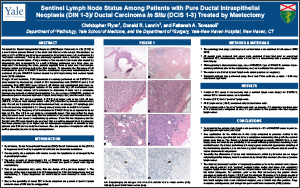Sentinel Lymph Node Status Among Patients with Pure Ductal Intraepithelial Neoplasia (DIN 1-3)/ Ductal Carcinoma In Situ (DCIS 1-3) Treated by Mastectomy
Christopher Flynn1, Donald R. Lannin2, and Fattaneh A. Tavassoli1
Department of 1Pathology, Yale School of Medicine, and the Department of 2Surgery, Yale-New Haven Hospital, New Haven, CT, USA
ABSTRACT
Introduction: Ductal Intraepithelial Neoplasia (DIN)/Ductal Carcinoma In Situ (DCIS) is a non-invasive process limited to the ducts and lobules of the breast. Nonetheless, as many as 9% of DIN cases have been reported to have lymph node (LN) involvement by “metastatic carcinoma.” Among the previously reported series, however, were cases suspicious for microinvasion. A large number of the reported cases were also treated by lumpectomy and consequently an occult infiltrating carcinoma may have gone undiagnosed. Confounding the issue, patients regularly have at least one if not multiple biopsies and/or aspirations before the final excision. To determine the frequency of LN involvement in cases of DIN/DCIS and the contribution of previous instrumentation, we evaluated all pure DIN/DCIS lesions treated by total mastectomy and sentinel lymph node (SLN) evaluation.
Design: At our institution, SLN assessment is routinely performed on all DIN/DCIS le-sions treated by mastectomy. A total of 252 mastectomies with DIN/DCIS and a SLN evaluation from 2002-2012 were retrieved. All clinical and pathological data were reviewed. The clinicopathological features of the cases with any LN involvement were compared to those without LN involvement to determine if there was a correlation between any lesional or clinical characteristics (i.e., size or type of DIN/DCIS, number of procedures prior to mastectomy/sentinel lymph node biopsy, etc.) and the nodal status.
Results: Of the 252 cases evaluated, 9 (3.6%) had tumor cells in the SLN. All nine (100.0%) of these were isolated tumor cells (ITC) identified by immunohistochemistry only. Overall, the 9 patients with nodal involvement had, on average, 3.7 samplings prior to the mastectomy compared to 2.1 among those patients with no nodal involvement.
Conclusions: The frequency of LN involvement in DIN/DCIS has been reported to be as high as 9%. The 3.6% in our study is substantially lower. This may reflect the more stringent criteria used in our study with the exclusion of any case with microinvasion and the limitation of our cases to mastectomy specimens. Given this low frequency and the fact that only ITC were found in the involved LNs, it would be reasonable to hypothesize that these patients are at no higher risk for subsequent metastasis or recurrence than patients with DIN and no nodal involvement. Also, the presence of neoplastic cells may well be secondary to prior sampling manipulations.
©2013 Yale Department of Pathology. All rights reserved.
Any redistribution or reproduction of part or all of the contents in any form is prohibited. You may not, except with express written permission of the author or the Department of Pathology, distribute or commercially exploit the content, nor may you transmit it or store it in any other website or other form of electronic retrieval system, including use for educational purposes.
